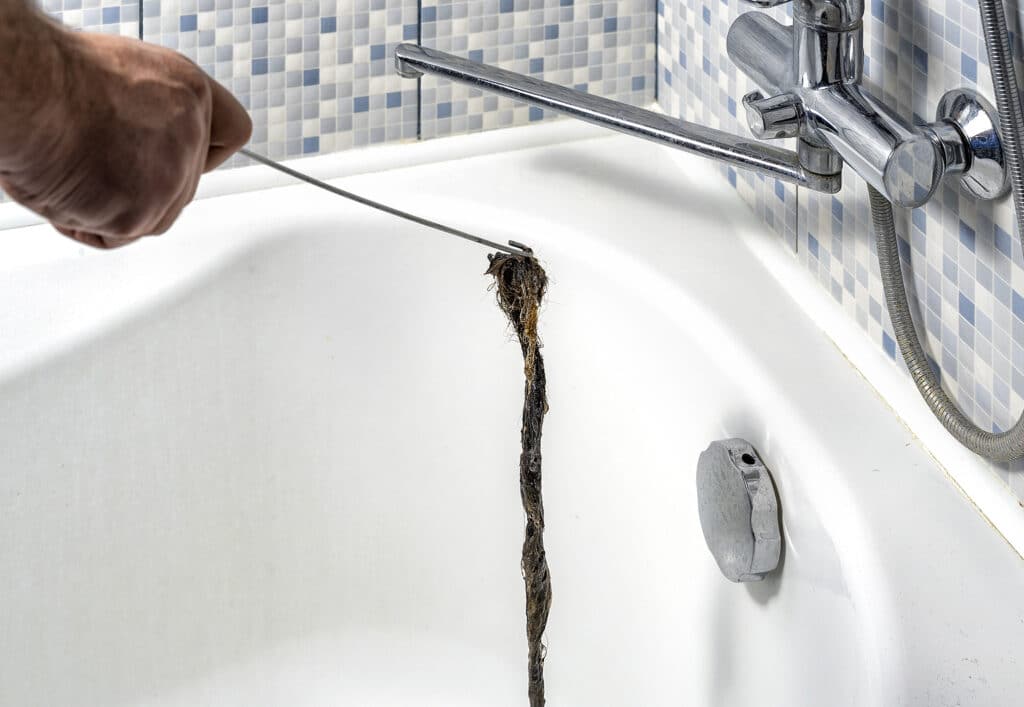
We’ve all been there. You’re using your bathroom sink, and the water slowly starts to fill the basin. Or you’re standing in a shower that is slowly but surely becoming a bath.
It can be extremely frustrating to deal with clogged plumbing, but if you have the tools on hand and know how to fix the problem, you can address it and get on with your day.
We’ve outlined our top tips for how to unclog a bathtub drain or sink in this article. We also share a few techniques you may want to use to get your sink, bathtub, or shower back in working order. Bookmark this page and use our guide next time you encounter a bathroom drain clog.
Try to Understand the Why the Drain is Clogged
To fix a clog, you first need to understand what’s causing it. Consider how you and your family used the sink recently. If you just gave your pup a bath, for example, you’d have to approach the clog (likely a build-up of hair) a bit differently than if it’s a greasy or soapy clog.
Often, the sources of drain issues in the bathroom are either soapy clogs or hair. But identifying the problem is the first step in figuring out how to unclog a tub or sink.
If you tried to figure out the clog’s exact source but can’t, all hope is not lost. You just might want to try a combination of the following approaches.
Repair method 1: Examine your drain and remove any visible blocks
You can start to diagnose a clog issue by removing the drain stopper and examining it for signs of hair or other debris. Sometimes, a clog is caused by issues right at the top of the drain, and merely removing the hair and debris resolves the problem.
You should clean your drain stoppers frequently anyway to ensure that the hair and debris caught on the stopper don’t flow down deeper into the drain.
Repair method 2: Try a plastic clog remover
One of the most effective, cheapest, and most straightforward ways to remove a clog is with a plastic clog remover, sometimes called a snake. These are long plastic pieces with hooks on either side, designed to grab onto debris and hair and pull it out of the sink.
Plastic clog removers can be handy if the issue is caused by hair or debris. You can purchase one of these for a few dollars at your local hardware store or supermarket.
To use a plastic clog remover, first insert it into the drain — you may have to remove drain covers to do this effectively. Once it’s inserted fully, slowly pull it out. It will grab hold of all the debris and hair and hopefully remove the problem-causing clog.
Repair method 3: Try hot water
You may have heard that boiling water can be used to clear your clogged drains. However, this can damage your plumbing. Using a basin full of hot (not boiling) water, on the other hand, is a safe approach.
Simply fill the sink basin fully with hot water and allow the sink to drain. The gravity of the water will apply pressure to the clog, hopefully forcing it out.
Repair method 4: Try a gentle solvent
If a manual method does not work, you might want to dry a chemical approach. In this case, you may have a grease clog on your hands.
Harsh chemicals can affect your plumbing and damage your pipes. Baking soda and vinegar are often recommended to clear clogs, but when baking soda and vinegar react, they neutralize each other. As you can imagine, that yields a less-than-effective solution.
However, you can often use hot water and some dish detergent to dissolve the clog. You likely already have these ingredients on hand, making this approach cost-effective and straightforward.
Start by pouring hot water down your drain to soften the clog. Follow this with a squirt of dish detergent down your drain, followed by some more hot water. The dish detergent will dissolve part of the clog, hopefully allowing it to become small enough to pass through the system.
Repair method 5: Use a plunger
You likely have a plunger hanging around. Plungers use a seal and compression, combined with a suction motion, to force water up and down in your drain. This moves water either way past the clog, hopefully loosening it up and breaking it down enough that it can pass.
But be aware — sink plungers and toilet plungers are usually shaped differently, and one might not work correctly for the other application. A cup-style plunger is best for a sink. To use a plunger, first make sure you have the right kind.
Next, block the overflow opening (the small hole in your sink basin). Use the plunger to form a seal around the sink and fill the sink with water up to the cup. Push down and pull up on the plunger several times. Then check to see if the water drains down the sink. If not, continue plunging.
When You Can’t Unclog a Drain on Your Own
If you’ve tried everything and nothing has worked, it’s time to call the professionals at R.J. Tilley who have the equipment to handle more difficult clogs. If you’re in the Richmond, Virginia area, you can find the information for a consultation on our website, or call us at (804)-355-7110.
If you think you might be dealing with a different issue, check out our article describing other common plumbing issues and how to fix them.








